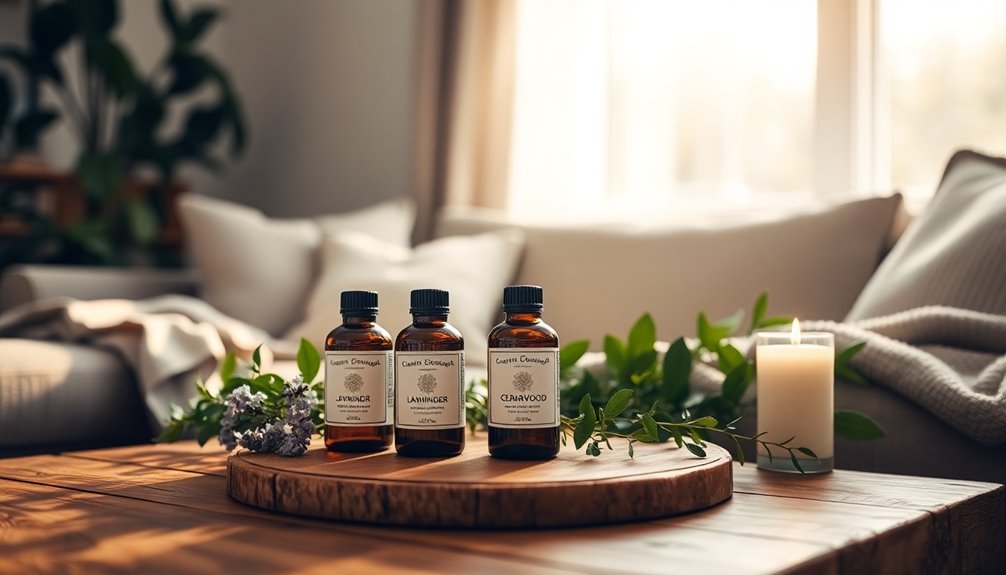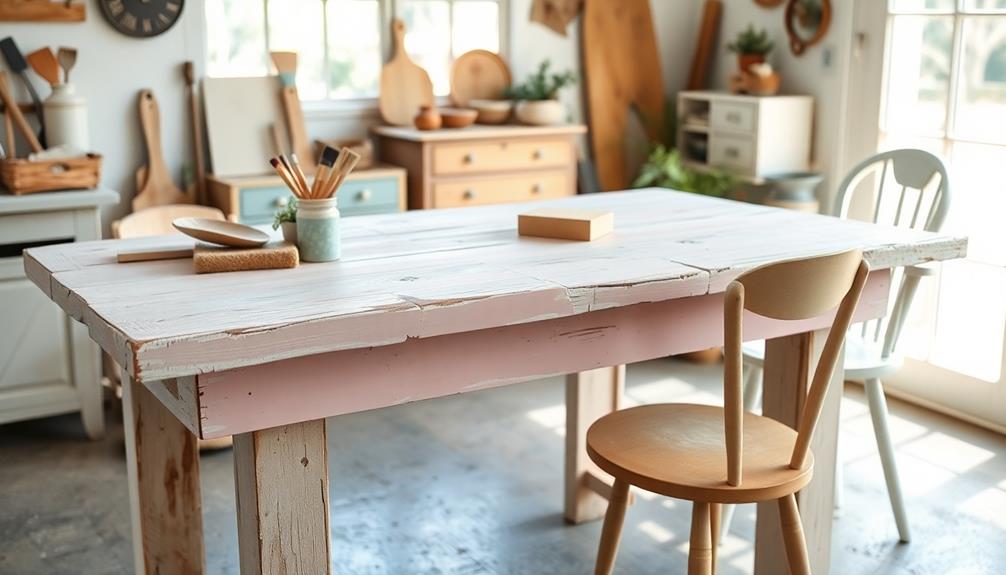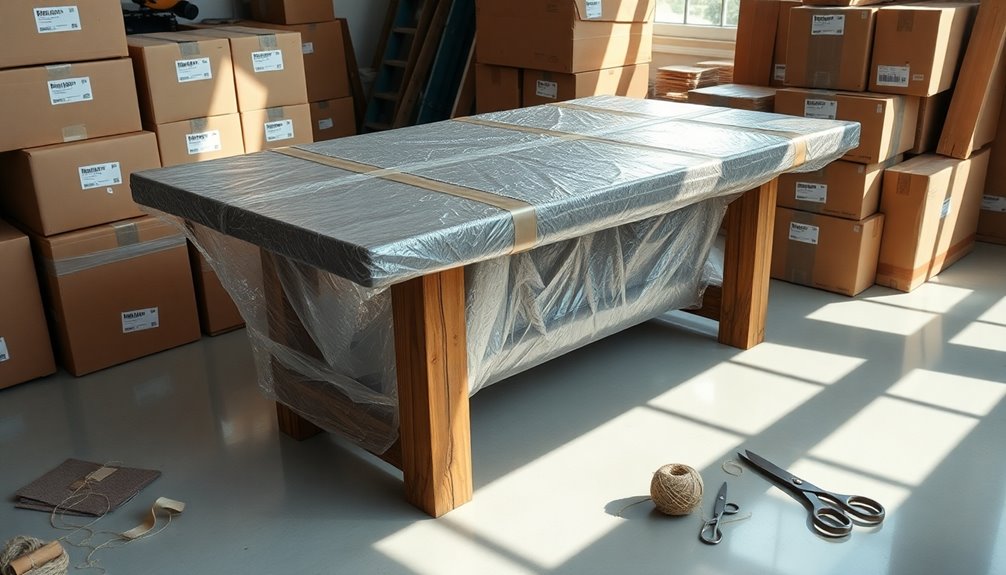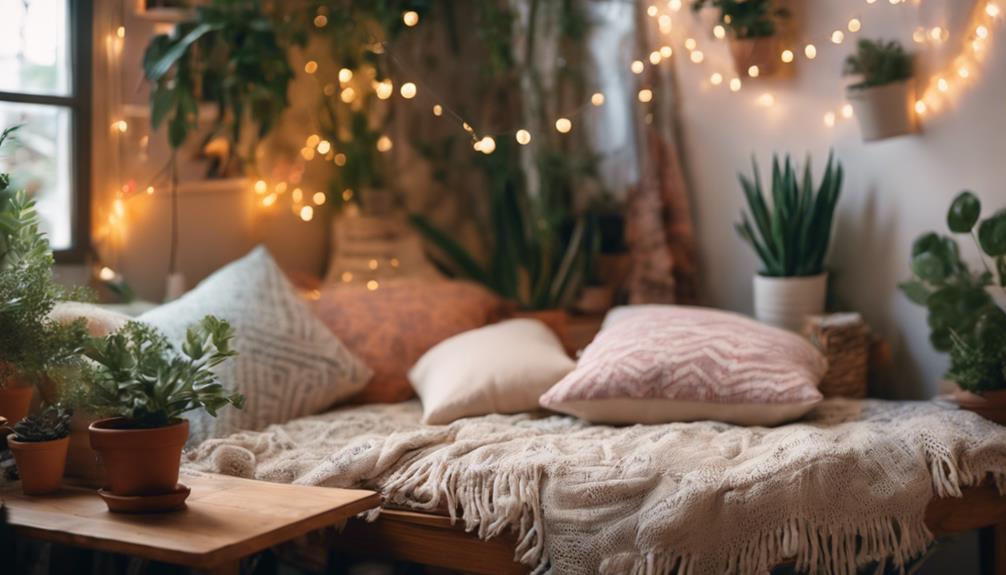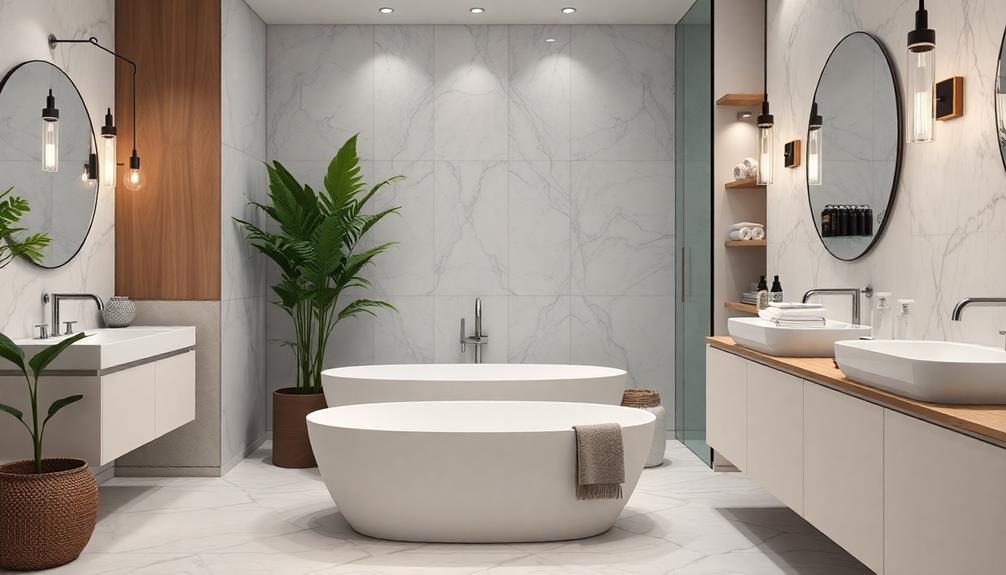To create the perfect atmosphere in your rooms, essential oil blends can work wonders. For calming spaces, mix lavender, cedarwood, and bergamot. Need a boost? Try sweet orange, grapefruit, and peppermint for energizing vibes. Seasonal themes shine with blends like "Sweater Weather" featuring fir and cinnamon or "Spiced Cider" that combines nutmeg and clove. If you're after an earthy feel, blend cedarwood with patchouli. For a romantic touch, opt for clary sage and vanilla. Each blend enhances your space's aesthetic and mood, so stick around to discover even more delightful combinations that suit your unique style.
Key Takeaways
- Calming Spaces: Use lavender, cedarwood, and bergamot for a tranquil atmosphere that promotes relaxation and restful sleep.
- Energizing Spaces: Blend sweet orange, grapefruit, and peppermint to invigorate energy levels and enhance mood in your environment.
- Seasonal Themes: Create cozy fall vibes with "Sweater Weather," combining fir, cinnamon, and neroli for warmth and comfort.
- Woodsy Ambiance: Combine cedarwood, frankincense, and rosemary for a fresh, earthy scent that promotes relaxation and improves air quality.
- Spicy and Exotic: Use nutmeg, star anise, and ginger for a warm, inviting atmosphere, perfect for colder seasons and cozy gatherings.
Calming and Relaxing Spaces
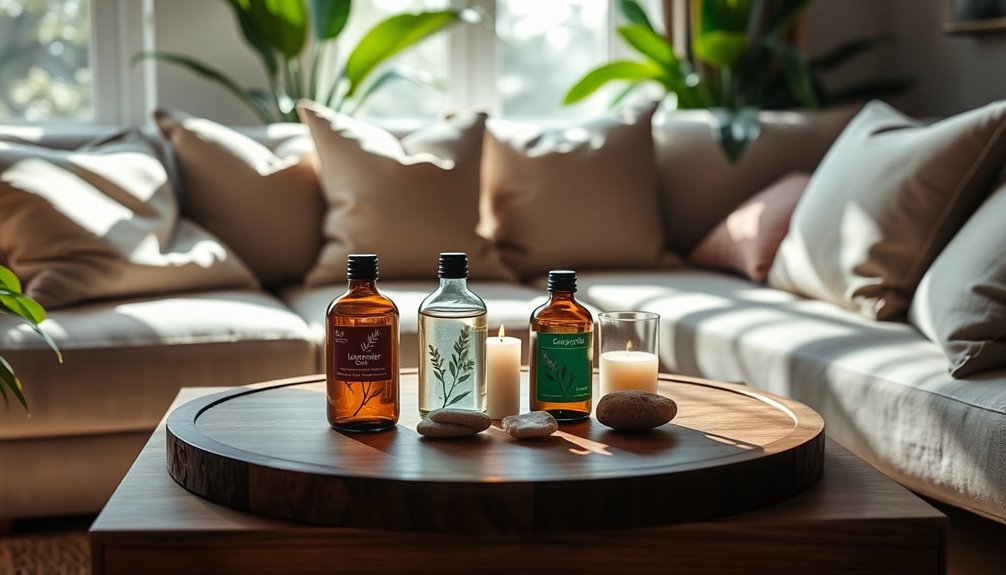
Creating calming and relaxing spaces can transform your home into a sanctuary. To achieve this, consider using essential oils that promote tranquility and comfort.
Start with lavender oil; it's renowned for its ability to induce relaxation and restful sleep. Pair it with Roman chamomile oil, which soothes and comforts your senses, creating a peaceful atmosphere. Aromatherapy can enhance mood and alleviate anxiety symptoms, making it an ideal addition to your relaxation routine.
Incorporate ylang-ylang oil for its soothing properties and delightful floral scent. Neroli oil can enhance this serenity, offering a glowing, floral aroma that wraps your space in calmness.
Geranium oil is another excellent choice, as it balances emotions and helps you feel more centered. Stress management strategies like incorporating essential oils into your daily routine can significantly improve your overall well-being.
Earthy and woody blends can also deepen your relaxation. Cedarwood oil brings a tranquil ambiance, while vetiver oil grounds and centers your mind and body. Frankincense oil is perfect for deepening your relaxation experience.
For a more complex blend, try combining lavender, cedarwood, and bergamot; this mixture will create a calming atmosphere throughout your home.
With these essential oils, you can easily craft an environment that invites peace and serenity into your daily life.
Invigorating and Energizing Spaces
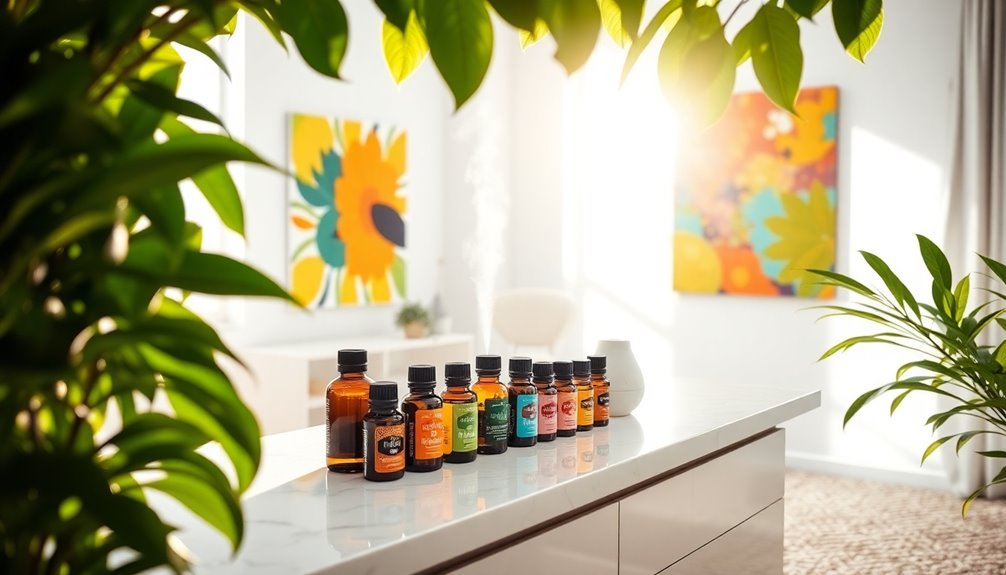
While calming spaces are perfect for relaxation, invigorating and energizing environments can boost your mood and productivity. To create such an atmosphere, consider using essential oils known for their uplifting properties. Bergamot is fantastic for combating stress, while grapefruit's bright fragrance helps recharge your energy. Lemon offers a citrusy aroma that lifts your spirits and increases productivity.
Try blending these oils for effective diffuser recipes. An energizing citrus burst combines sweet orange, grapefruit, and lemon for a refreshing scent. For a revitalizing morning blend, mix sweet orange, peppermint, and rosemary to wake up your senses. If you need to feel more alert, the fresh and focused blend of bergamot, frankincense, and peppermint will do the trick. Aromatherapy can enhance mood and improve cognitive performance, making these blends even more effective.
These essential oils not only enhance focus but also improve your overall mood. The combination of citrus and herbaceous oils, like lemon and rosemary, creates a synergistic effect that energizes you.
Additionally, minty oils like peppermint paired with eucalyptus provide a refreshing aroma, perfect for boosting concentration. By incorporating these blends, you can transform your space into an invigorating haven that energizes your mind and body.
Fall and Autumn-Themed Spaces
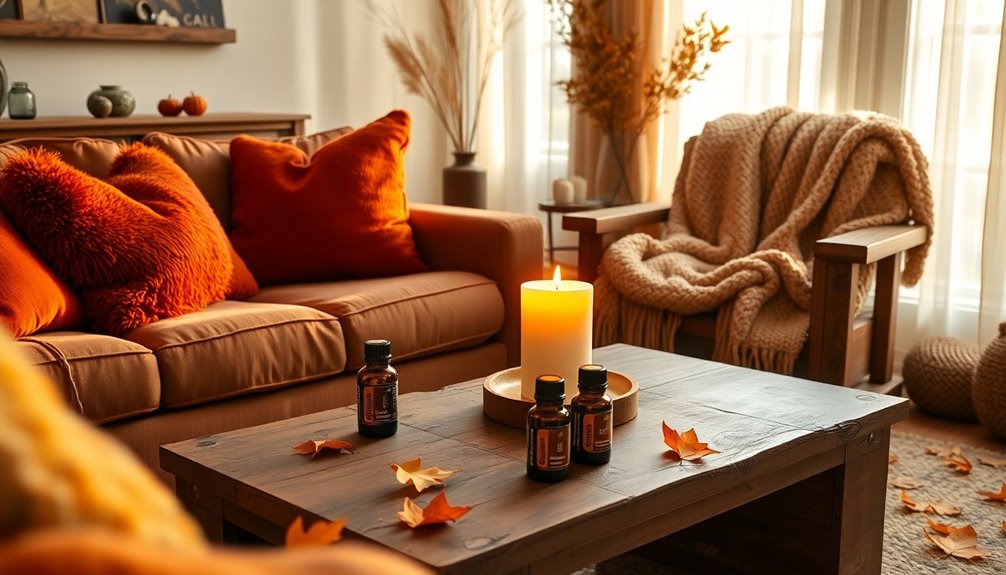
As the leaves change color and the air turns crisp, you can easily transform your space into a cozy autumn retreat. To embrace the essence of fall, consider blending essential oils that evoke warmth and comfort. For a "Sweater Weather" ambiance, mix 2 drops of fir or pine, 2 drops of cinnamon, and 1 drop of neroli essential oil. This combination creates a soothing and inviting atmosphere.
If you're looking for something reminiscent of "Autumn Mornings," try 2 drops of cinnamon, 2 drops of sandalwood, and 2 drops of vanilla oleoresin. This blend captures the essence of crisp mornings filled with the scent of baked goods, while also incorporating woody oils that ground the fragrance.
For a festive vibe, the "Pumpkin Picking" blend of 2 drops of sweet orange, 2 drops of cinnamon, and 2 drops of clove essential oil will have your space smelling delightful.
You can also enjoy the "Spiced Orange" blend, which includes 5 drops of orange, 1 drop of cinnamon, 1 drop of clove, and 1 drop of nutmeg essential oil.
These blends will surely help you celebrate the beauty of fall in your home!
Woodsy and Earthy Spaces
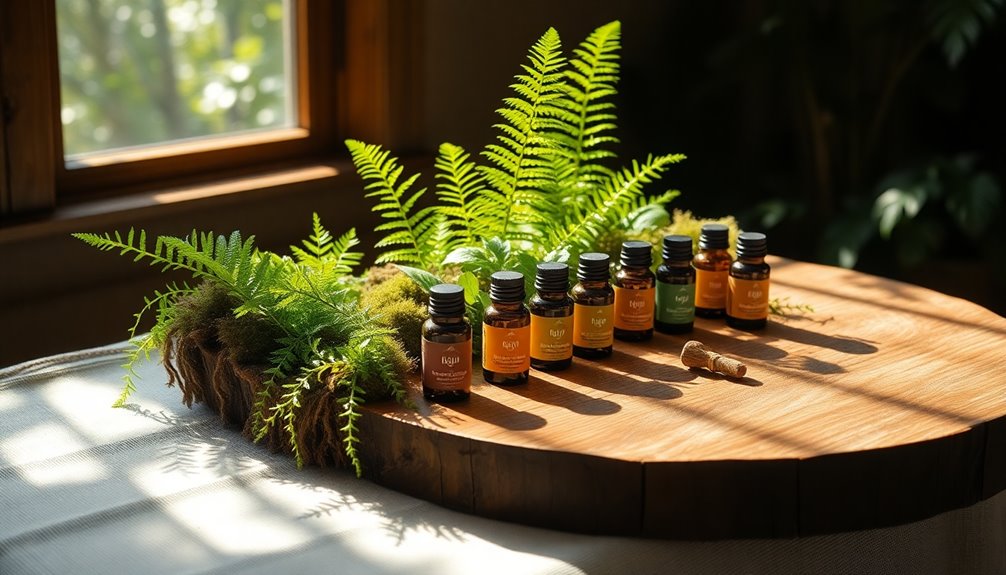
Transforming your space into a woodsy and earthy retreat can enhance your mood and promote relaxation. To achieve this, consider incorporating essential oils known for their calming effects. Cedarwood, with its soothing properties, is a fantastic choice. Additionally, using therapeutic-grade oils ensures you receive the maximum benefits from your blends. Essential oils like lavender oil can also contribute to a tranquil atmosphere.
Pine offers a fresh, earthy aroma that can help clear your mind, while cypress delivers a woodsy, smokey scent perfect for reducing stress.
You can create your own blends for an inviting atmosphere. Try the "Forest Fresh" blend with five drops of cedarwood, three drops of frankincense, and two drops of rosemary for a relaxing environment.
Alternatively, "Retreat to Nature" combines four drops of Douglas fir, three drops of cedarwood, and three drops of cypress, ideal for unwinding after a long day.
For a refreshing touch, consider the "Mountain Getaway" blend, mixing two drops each of bergamot, cedarwood, grapefruit, spruce, and juniper.
All these blends help improve air quality and mask unwanted odors, making your space feel more inviting. Embrace the woodsy essence and let these aromas transport you to serene, nature-filled surroundings.
Spicy and Warm Spaces
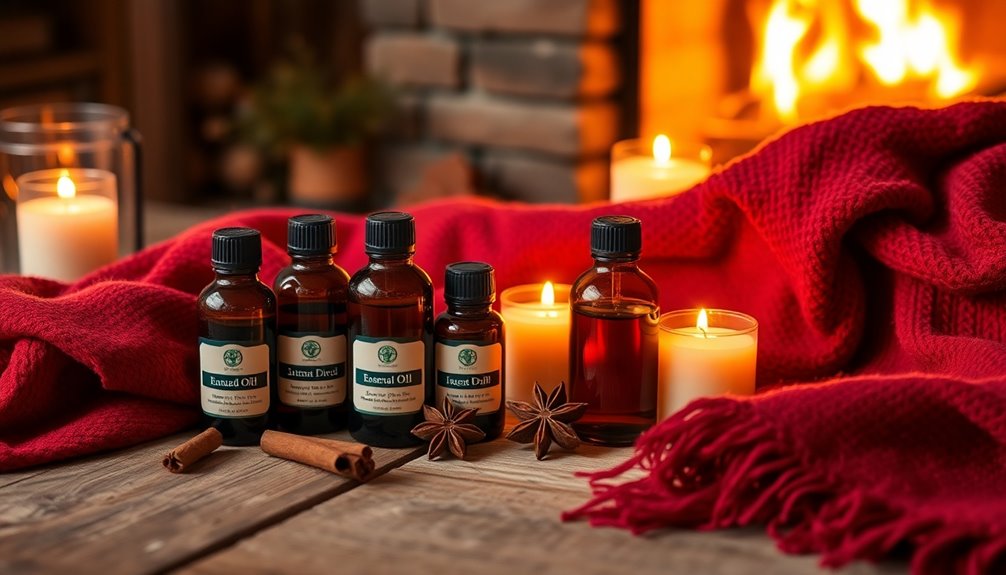
Creating a spicy and warm ambiance in your home invites comfort and coziness, perfect for chilly evenings or gatherings with friends. To achieve this inviting atmosphere, consider using essential oils that evoke warmth and spice.
Nutmeg, with its slightly sweet aroma, pairs beautifully with the licorice-like scent of star anise. Ginger adds a vibrant note, ideal for autumn and winter blends, while cinnamon brings a strong, inviting aroma. Clove contributes a pungent spice, often found in seasonal mixes. Aromatherapy sessions can be enhanced with these oils to promote relaxation and emotional well-being.
For a delightful blend, try the Spiced Cider Blend, which combines nutmeg, star anise, ginger, cinnamon, cardamom, and clove. Alternatively, the Wood Spice Blend offers a cozy mix of woody notes with spicy elements. You might also enjoy the Fall Vibes Collection, which features essential oils like Pumpkin Pie and CinnaBake, enhancing your cozy atmosphere.
You can also create your own DIY Winter Spice Blend using cinnamon, ginger, and nutmeg, allowing for customization to match your personal preferences. Regular use of these essential oils can create a positive environment, reducing stress and enhancing the overall experience.
Incorporate these essential oils into products like candles and bath bombs to enhance the spicy and warm ambiance. Remember to maintain a balance of scents and use high-quality oils to ensure your space feels inviting and comforting all season long.
Floral and Soothing Spaces
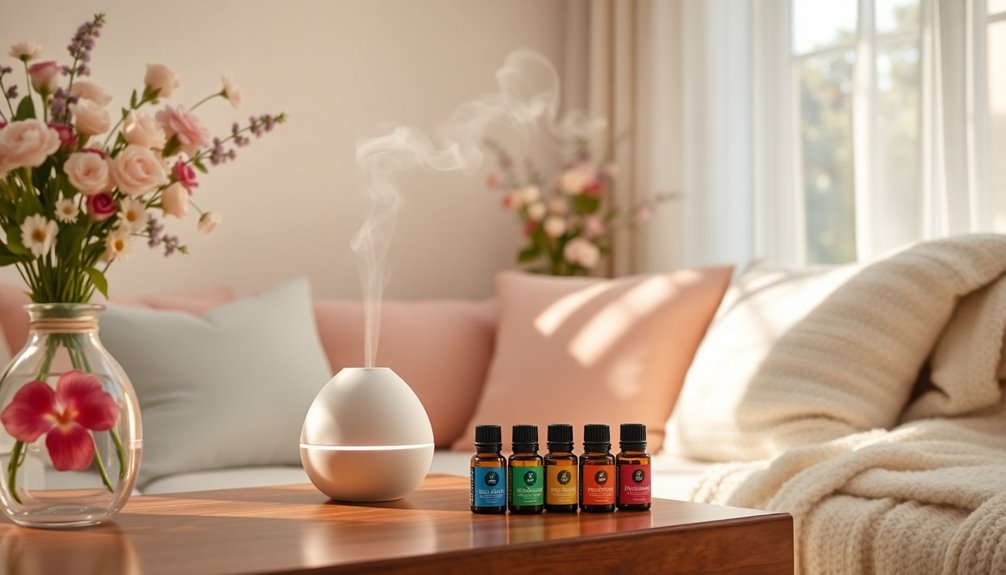
While you might seek a tranquil retreat from the hustle and bustle of daily life, floral and soothing essential oils can effortlessly elevate your space into a serene sanctuary.
Lavender is a go-to choice, renowned for its calming and therapeutic properties that support mental well-being. You can also try geranium, which balances emotions and has uplifting qualities, making it perfect for personal care.
Consider blending gardenia and tuberose for a rich, floral aroma that fills your space with sweetness. For relaxation, the "Farmers Market Flowers" blend combines lavender, ylang ylang, gardenia, and tuberose, creating a soothing atmosphere. Additionally, these blends are designed to reflect fresh and floral spring scents, enhancing your overall ambiance.
Alternatively, "Sweet Dreams" incorporates lavender, cedarwood, and lemon verbena to promote restful sleep.
You can diffuse these oils, apply them topically with a carrier oil, or even mist them on your linens for a refreshing touch. Inhaling directly or adding them to your warm bath can also enhance the experience.
Not only do floral essential oils help relieve stress and promote mental clarity, but they also purify the air, making your space feel rejuvenated and calm. Embrace the floral scents for a truly soothing environment!
Citrus and Fresh Spaces
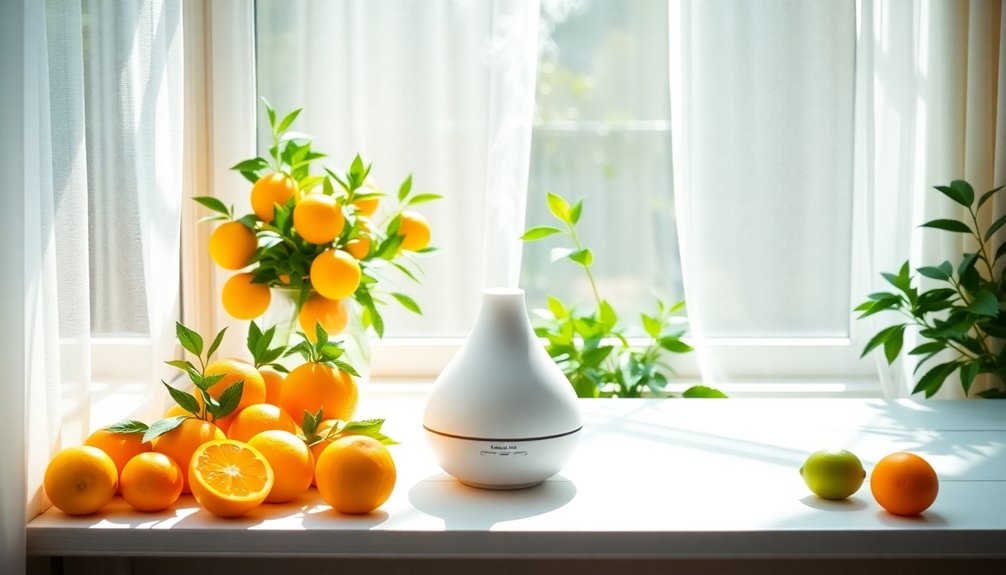
After cultivating a soothing floral environment, it's time to invigorate your space with the bright and refreshing scents of citrus essential oils. These uplifting aromas can enhance your mood, alleviate stress, and even reduce feelings of fatigue. Imagine the revitalizing scent of Grapefruit or Lime energizing your day!
Diffusing citrus blends like Citrus Fresh, which combines Orange, Tangerine, and Spearmint, can freshen the air and eliminate unwanted odors. You can also take advantage of the detoxifying properties of Juniper when using blends like Boost, which features Grapefruit and Bergamot. Incorporating these oils into your routine may also promote skin safety when diluted properly.
For a multi-dimensional approach, consider adding citrus essential oils to your cleaning products. They enhance cleaning properties while removing greasy residue and leaving a refreshing scent.
You can also incorporate them into your culinary creations, adding flavor and antioxidant benefits to your dishes.
Whether you opt for topical applications or DIY bath products, citrus oils are versatile and invigorating. They're not just about scent; they're about transforming your space into a lively oasis.
Embrace the brightness of citrus essential oils and watch your environment come alive!
Herbal and Therapeutic Spaces
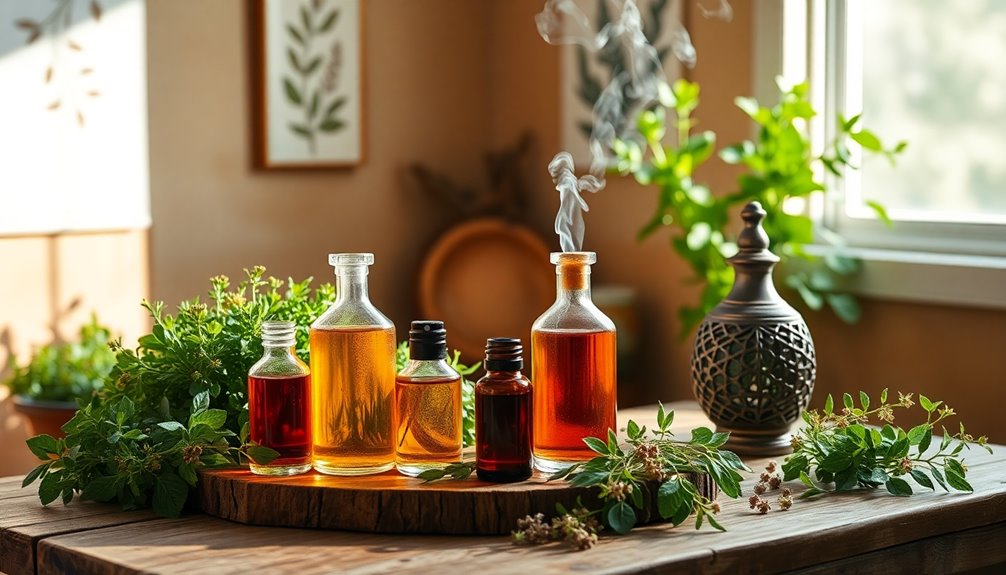
There's something undeniably comforting about the soothing scents of herbal essential oils that can transform your space into a therapeutic haven. By incorporating oils like lavender and Roman chamomile, you'll create an atmosphere that promotes relaxation and reduces anxiety. Research has shown that aromatherapy can enhance emotional well-being, making it an effective tool for stress relief.
Bergamot eases stress, while valerian helps improve sleep quality, making your environment a sanctuary for rest. A holistic approach to well-being can also enhance your experience, as it addresses both the body and mind.
To enjoy these benefits, try diffusing the blend in your essential oil diffuser before bedtime or during your relaxation time. You can also add a few drops to a warm bath for a soothing soak or dilute them in a carrier oil for a calming massage.
For an extra touch, incorporate these oils into your DIY skincare products.
The synergistic effects of these calming oils amplify their therapeutic properties, cleansing your mind and soul while promoting balance. This blend not only ensures a restful night's sleep but also supports respiratory health, creating a refreshing atmosphere.
Sweet and Comforting Spaces
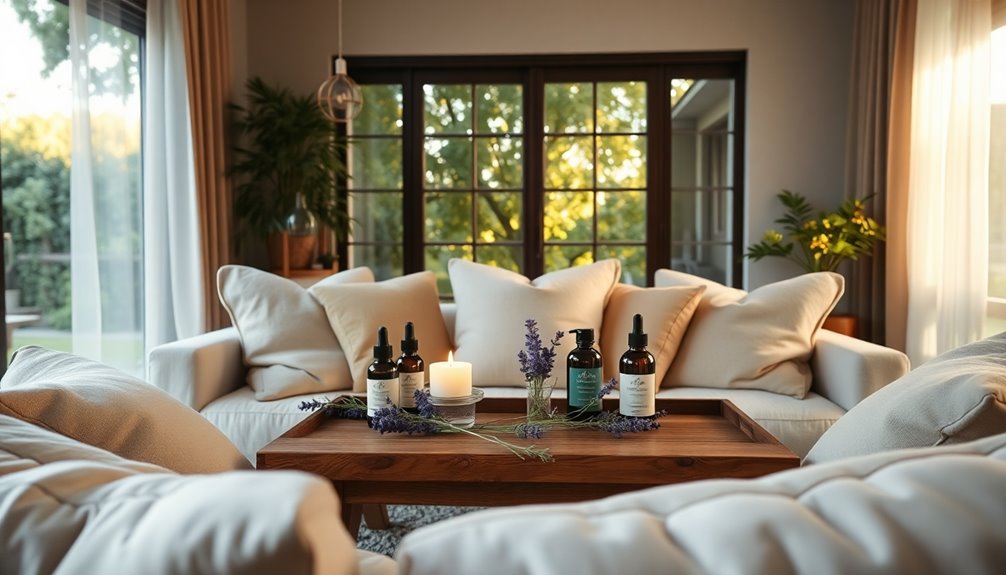
Creating a soothing atmosphere doesn't just stop at relaxation; it can also be about warmth and comfort. To achieve this, you can blend essential oils that evoke a sweet and inviting environment.
Start with lavender, known for its calming properties and soft floral scent. Combine it with chamomile and vetiver to promote peaceful sleep, or mix lavender with orange and bergamot for a cheerful ambiance. Incorporating relaxation techniques can further enhance the soothing effects of these blends. Additionally, considering the recommended quantity of essential oils for candles can help you achieve the perfect scent throw in your space.
For that cozy, welcoming feel, try a blend of cinnamon, nutmeg, and orange. This combination brings the essence of fall into your space.
Alternatively, mix black spruce, cedarwood, and vanilla for a festive, evergreen forest vibe. If you're looking for a kid-friendly option, go for mandarin, lavender, and chamomile to create a serene atmosphere.
Don't forget about the grounding effects of earthy blends. For instance, patchouli, cedarwood, and vetiver stabilize your environment while promoting calmness. Understanding the importance of dilution guidelines can also ensure safe and effective use of these oils.
With these essential oil blends, you can effortlessly transform your space into a sweet and comforting haven where you feel completely at ease.
Exotic and Mystical Spaces
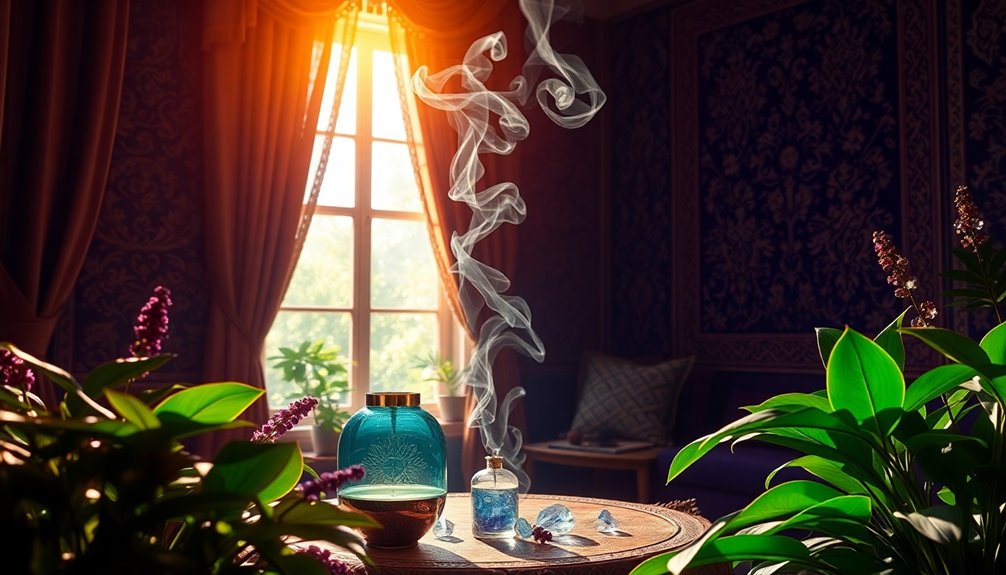
Exotic and mystical spaces invite you to escape the ordinary and embrace a world filled with rich aromas and enchanting vibes. To create such an atmosphere, consider using essential oil blends that evoke romance and spiritual tranquility. Combine nutmeg, lavender, and orange for an uplifting yet soothing environment.
Alternatively, mix clary sage, ylang ylang, and vanilla to enhance sensuality. You can diffuse these blends in your space, allowing the warm, spicy, and citrus notes to envelop you.
For a more immersive experience, add these oils to your bath, diluted with a carrier oil like coconut or jojoba. This not only enhances your bathing ritual but also stimulates your senses. The mystical essential oil blend is particularly noted for its cleansing properties, making it an excellent addition to your aromatic collection.
In addition to diffusing, you can craft custom aromatherapy products by blending these oils with unscented body care products. This personalization allows you to tailor the scents to your preferences while benefiting from their emotional and physical properties.
Whether you seek to promote relaxation, cleanse the spirit, or uplift your mood, exotic and mystical essential oil blends are your gateway to a captivating sanctuary. With their enchanting aromas and therapeutic properties, these blends have the power to transform any space into a tranquil retreat. Discover the art of aromatherapy and let the scents envelop you in comfort and serenity. In our latest strongmocha news group announcement, we unveil a selection of unique essential oil blends tailored to meet your needs for relaxation and rejuvenation.
Embrace these powerful aromas to transform your space into a haven of serenity and allure.
Frequently Asked Questions
How Do I Mix Essential Oils Safely at Home?
To mix essential oils safely at home, always dilute them with a carrier agent. Use a small glass bottle, test small batches, and store your blends in a cool, dark place for longevity and safety.
Can Essential Oils Be Used for Cleaning Purposes?
Yes, you can use essential oils for cleaning purposes. They offer antibacterial, antiviral, and antifungal properties, making them effective in combating germs and odors. Just mix them with water or vinegar for a natural cleaning solution.
What Are the Best Storage Practices for Essential Oils?
To store essential oils effectively, use dark glass bottles, keep them in a cool, dark place, and ensure tight seals. Handle them with clean tools, label them, and monitor for signs of deterioration.
Are There Any Essential Oils Unsafe for Pets?
Yes, some essential oils are unsafe for pets. Oils like tea tree, peppermint, and eucalyptus can be toxic, causing skin irritation or respiratory issues. Always consult a vet before using essential oils around your pets.
How Long Do Essential Oil Blends Last Once Mixed?
Essential oil blends can last varying lengths depending on their form. Room sprays might last weeks to months, while diffuser blends last until depleted. Always consider dilution, storage, and environmental factors to maximize longevity.
Conclusion
No matter the vibe you want to create in your space, there's an essential oil blend that can enhance it. From calming and relaxing scents to invigorating and energizing aromas, these blends can transform your environment. Whether you're cozying up in a sweet, comforting room or seeking the warmth of spicy notes, experimenting with different combinations can lead to a unique atmosphere. So, go ahead—mix and match your favorites to find the perfect scent for your space!
